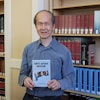Cilantro is a good example for showing the stupidity of racial stereotypes.
The herb, also known as coriander and Chinese parsley, is a staple in some cuisines to the surprise of diners of varying backgrounds who report it tastes like soap. It turns out that whether you like this seasoning or want to spit it out depends on your genetics — your heritage. Yet even though there is a biological basis for the visceral reaction, these tendencies cannot be relied upon because the aggregates and averages are too false and too general. Since people likely won’t be offended by any demonstration that depends on cilantro, it is perfect to use to prove a point.
The simplest reports on cilantro are that Asians like it, but Europeans don’t. Asian Americans are like Asians, White Americans like Europeans, which accords with assumptions based on ancestry. These propensities are fact. But they are not absolutes (Mexican cuisine involves cilantro, too. It is the greenery in a red salsa.).
 Frank Wu
Frank WuTo begin with, there are differences among Asians by specific ethnicity and Europeans by specific ethnicity. It is a matter of percentages. Ashkenazi Jews display a propensity to dislike cilantro, but even within that community it is apparently about one in seven who hate it. A Portuguese specialty is a soup heavy on cilantro. So the categories of Asian and European are too vague. They do not quite explain enough.
More importantly, however, even within these ethnicities, there is considerable variation. Among the Asian populations that cook with cilantro, there are more than a few individuals who do not want it in their dishes if they have a choice. Among the European populations that do not boast recipes calling for cilantro, there are more than a few individuals who enjoy it or at least tolerate it.
The same can be said of all distributions along a bell curve. A generation ago, when demagogues revived discredited theories about bell curves, people were outraged about the public policy suggestions that followed. They also could have objected about the poor evidence the claims had at their foundation. The supposed formula has been repeated by those trying to justify or excuse both discrimination and disparities. Socioeconomic status is correlated to intelligence scores; and intelligence scores are correlated to race. Accordingly, any gap between haves and have-nots is natural and ought not be regarded as problematic.
For the sake of argument, even if the propositions are accepted, the conclusions do not follow. Suppose that wealth were related to IQ, which in turn were related to identity (There are many additional arguments based on objective criteria: the other variables, such as inherited status, that count; the biases of IQ tests; and the uncertainty of background assigned by skin color.).
Cilantro shows why. It is the same set of issues. Yes, there is a rough relationship of enthusiasm for this flavor with lineage. But it is only approximate. Such guesswork would produce unacceptable errors in any high-stakes decision-making. The better course if you are a considerate host would be to ask dinner guests if they care to partake of this garnish, not to put it atop the entree served to Asians but hold back with Europeans, sprinkle it on for Portuguese but not Ashkenazi Jews, Mexicans more than other Latinos.
The most persuasive rebuttals of bell curve polemics took on the pseudo-science along the lines not of ideology but of science. Sophisticated authors, expert in demographics, noted that the bell curves being drawn all overlap. Outliers are by definition rare in relative terms, but they are not uncommon in absolute terms with a global population in the billions. That means that there are many African-Americans who are perceived as much less smart than they are — and, wrongly, compared to White Americans at the other tail of the bell curve — as well as more than a few White Americans who are privileged to be treated as more smart than they are (The same is true of gender. The mean and median heights and weights of males and females in our species indicate men are taller and heavier than women, if you want to be very general, but it is obvious that there are men shorter than women and women heavier than men, and every combination that can be imagined. If you want to select for height or weight, which is not typically legitimate, the proxy of gender is not needed.).
The more we learn about nature, the more we can appreciate nurture. Epigenetic factors, the environmental influences that activate genetic expressions, can be as important as the DNA embedded within each cell. There is so much that remains latent in us, positive and negative, which can be called forth. Racial discrimination itself plays such an important role, it is being proven, in health outcomes: it may be as much the discrimination against African-Americans in daily life and in treatments prescribed, as the race of African-Americans, that aggravates health outcomes such as hypertension.
The progressive agenda can be framed in utilitarian terms. The business case for diversity is based on benefits and costs. It isn’t restricted to the appeal to abstract rights. It is the notion that there are gains that can be measured by having a workforce that is inclusive, and losses that are incurred by practicing or even catering to bias and exclusion. The analysis is a subtle pitch for self interest. A businessperson herself will be better off, if she follows principles that unite rather than divide.
In opposing racism, every argument should be called upon. It can be persuasive to preach. The immorality of prejudice is a powerful critique. Yet numbers can be as persuasive as words. The data is on the side of justice. Try an experiment. Ask colleagues about cilantro.
Frank H. Wu is the William L. Prosser Distinguished Professor at the University of California Hastings College of the Law. You can follow him on Twitter @Frankhwu















